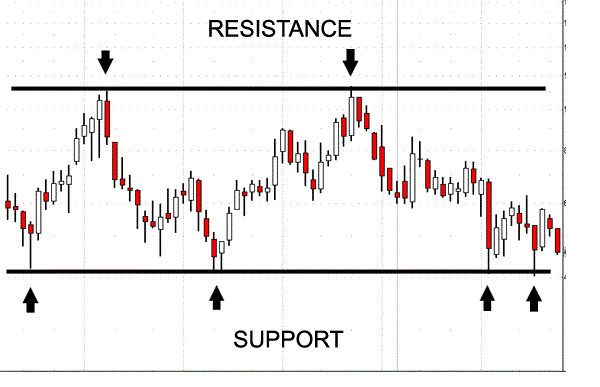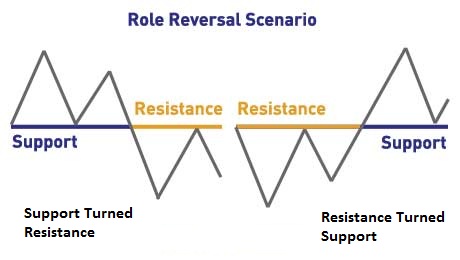Definition of Support And Resistance
Support and Resistance levels represent key price levels where the forces of supply and demand meet.
In the forex market, the prices are driven by supply and demand.
If there is an oversupply, prices will go down and if there is a demand, price will go up. If demand and supply even out, price then tend to move sideways in a range.
Demand is synonymous with bulls(buyers) and supply is synonymous with bears(sellers).
Now what is Support?
Support is the price level at which demand is thought to be strong enough to prevent the price from declining further. The means that as the price declines towards support(which means it gets cheaper), buyers become more inclined to buy and sellers become less inclined to sell. By the time the price reaches the support level, it is believed that demand will overcome supply and prevent the price from falling below support.
Now lets look at Resistance…
Resistance is the price level at which selling is thought to be strong enough to prevent the price from rising further. The means that as the price advances towards resistance, sellers become more inclined to sell and buyers become less inclined to buy. By the time the price reaches the resistance level, it is believed that supply will overcome demand and prevent the price from rising above resistance.
How Do You Determine Support And Resistance Levels?
Simple…based on the highs and lows. You see, to determine support, look for previous reaction lows(in the chart above, notice the 4 black upward arrows, these are previous reaction lows).
Also on the same token, to determine resistence level, look for previous reaction highs.
When Support Equals (Or Resistance Equals Support)
To better understand support and resistance levels you also need to know when a support may become a resistance level or vice versa.
This is better know as Support-Turned-Resistance or Resistance-Turned-Support.
This is the theory behind Support Turned Resistance Levels: Once the price breaks below a support level, the broken support level can turn into resistance. The break of support signals that the forces of supply have overcome the forces of demand. Therefore, if the price returns to this level, there is likely to be an increase in supply, and hence resistance.
Resistance Turned Support Level: As the price advances above resistance, it signals changes in supply and demand. The breakout above resistance proves that the forces of demand have overwhelmed the forces of supply. If the price returns to this level, there is likely to be an increase in demand and support will be found.
The Importance of Support And Resistance Levels
Big price moves happen at support and resistance levels, either due to price bouncing off it or price intersecting(breaking) those levels.
Therefore, the identification of key support and resistance levels is very important for successful technical analysis.
Yes, there will be times when it will be difficult to clearly establish the exact support and resistance levels, but being aware of their existence and location can greatly enhance your technical analysis and forecasting abilities.
You see, if a currency pair is approaching an important support level, it can serve as an alert to be extra vigilant in looking for signs of increased buying pressure and a potential reversal.
Or on the other hand, if a currency pair is approaching a resistance level, it can act as an alert to look for signs of increased selling pressure and potential reversal.
What Happens When A Support Or Resistance Level Is Broken?
Well, its pretty simple, isn’t it? If a support or resistance level is broken, it signals that the relationship between supply and demand has changed. A resistance breakout signals that demand (bulls) has gained the upper hand and a support break signals that supply (bears) has won the battle.
Did you enjoy this? It would mean the world to me if you shared it:






 Posted in
Posted in